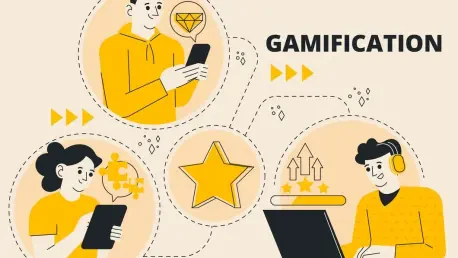Setting the Stage: The Gamification Revolution in Brand Engagement
Imagine a world where scrolling through a brand’s app feels less like a chore and more like an exciting challenge, complete with rewards and a sense of achievement that keeps users coming back for more. In today’s hyper-competitive digital marketplace, this is no longer a distant dream but a tangible reality driven by gamification. As consumer attention becomes an increasingly scarce commodity, brands are turning to game-inspired strategies to captivate audiences and build lasting loyalty. This market analysis dives deep into the role of gamification within marketing, exploring current trends, measurable impacts, and projections for its evolution. By examining data, case studies, and emerging technologies, this discussion aims to uncover why gamification has become a critical tool for brands seeking to stand out and how it will shape the future of customer engagement.
Market Trends: The Rise of Gamification as a Strategic Powerhouse
Adoption Across Industries and Platforms
Gamification, defined as the integration of game mechanics into non-game contexts, has seen a remarkable surge in adoption across diverse industries, from retail to healthcare. Brands are increasingly embedding elements like leaderboards, challenges, and reward systems into digital campaigns to transform passive interactions into active participation. A notable trend is the proliferation of mobile-based gamified experiences, capitalizing on the widespread use of smartphones to reach consumers directly. Data indicates that nearly 70% of global businesses have incorporated some form of gamification into their marketing efforts as of this year, reflecting a shift toward experience-driven strategies over traditional advertising methods.
Data-Driven Insights on Engagement Growth
Current market analysis reveals that gamification can boost customer engagement rates by up to 47%, a figure that highlights its potency in a landscape where attention spans are shrinking. This growth is particularly evident in sectors prioritizing digital touchpoints, where interactive campaigns often outperform static content in both reach and retention. However, a significant portion of brands still approach gamification as a superficial tactic rather than a core strategy, limiting their ability to harness its full potential. The challenge lies in aligning game mechanics with specific business goals to ensure meaningful outcomes rather than fleeting novelty.
Regional Variations and Technology Access
Geographic disparities also play a crucial role in the adoption and effectiveness of gamification. Markets with high digital penetration, such as North America and parts of Europe, exhibit stronger responses to app-based gamified campaigns, while regions with limited technology access face barriers to implementation. This uneven landscape suggests that brands must tailor their approaches based on local consumer behavior and infrastructure. As mobile connectivity continues to expand globally, the opportunity to bridge these gaps grows, potentially leveling the playing field for gamification’s reach in the coming years.
Market Impact: How Gamification Drives Business Results
Tangible Outcomes from Interactive Campaigns
The measurable impact of gamification on business performance is a key driver of its market relevance. Campaigns integrating game elements often achieve higher interaction rates, translating into concrete results like increased sales and customer retention. A standout example is a beverage brand’s digital campaign where players completed in-game tasks tied to real-world actions, resulting in over 500,000 unique plays and a 70% redemption rate for promotional offers. Such outcomes demonstrate that gamification can serve as a multifaceted tool, simultaneously enhancing brand visibility and driving commercial success.
Emotional Resonance and Long-Term Loyalty
Beyond immediate metrics, gamification excels at creating emotional connections that foster enduring customer relationships. By tapping into innate human desires for achievement and reward, gamified experiences leave a lasting impression compared to conventional marketing tactics. Brands that weave their unique stories and values into these interactions can build trust and authenticity, encouraging repeat engagement. The risk, however, lies in poorly designed campaigns that feel disconnected from a brand’s identity, which can alienate rather than attract consumers.
Overcoming Implementation Challenges
Despite its benefits, the market faces hurdles in fully embracing gamification, including misconceptions about its complexity and applicability. Many assume it requires extensive resources or is unsuitable for certain demographics, leading to hesitancy in adoption. Additionally, concerns around data privacy and regulatory compliance emerge as significant barriers, especially when campaigns collect user information. Addressing these challenges through strategic planning and transparent practices is essential for brands to maximize gamification’s value across varied market segments.
Future Projections: The Next Frontier of Gamified Marketing
Technological Innovations Shaping the Landscape
Looking ahead, the gamification market is poised for transformative growth fueled by advancements in technology. Augmented reality (AR) and virtual reality (VR) are expected to redefine engagement by offering immersive environments that blur the line between digital and physical experiences. Artificial intelligence (AI) also holds promise for personalizing gamified content at scale, adapting challenges and rewards to individual user preferences in real time. These innovations suggest a future where gamification becomes even more integrated into everyday consumer interactions.
Economic and Regulatory Influences
Economic factors, such as the demand for cost-effective digital marketing solutions, are likely to accelerate gamification’s adoption over the next few years. At the same time, evolving regulations around data usage and consumer privacy will shape how brands design and deploy these strategies. Markets must balance the need for personalized experiences with ethical considerations, ensuring compliance without sacrificing creativity. This dynamic interplay of economics and policy will be a defining factor in gamification’s trajectory through 2027 and beyond.
Predicted Market Dominance
Industry projections indicate that gamification will evolve from a niche tactic to a cornerstone of digital marketing within the next five years. As competition intensifies and consumer expectations for engaging content rise, brands that invest in gamified strategies now are likely to gain a competitive edge. The focus will shift toward seamless integration across omnichannel platforms, ensuring that gamification enhances every touchpoint of the customer journey. This trend underscores the urgency for businesses to adapt and innovate in response to an ever-changing market landscape.
Reflecting on the Analysis: Strategic Pathways Forward
Looking back on this market analysis, it is evident that gamification has solidified its position as a vital component of modern marketing, with data showcasing up to a 47% increase in engagement and real-world campaigns demonstrating significant business impacts. The exploration of regional variations and technological advancements highlighted the complexities and opportunities within this space. Emotional connections fostered through gamified experiences proved to be a powerful driver of loyalty, while challenges around implementation and privacy required careful navigation. For brands, the next steps involve adopting structured frameworks to align gamification with overarching goals, prioritizing authenticity in storytelling, and staying ahead of technological curves like AR and AI. By viewing gamification not as a gimmick but as a sustainable strategy, businesses can position themselves to thrive amidst evolving consumer demands and market dynamics.









